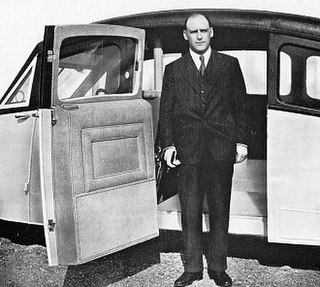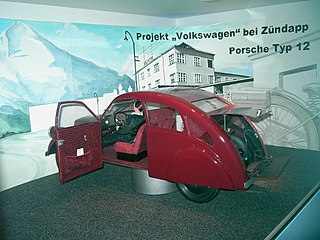
The Dymaxion car was designed by American inventor Buckminster Fuller during the Great Depression and featured prominently at Chicago's 1933/1934 World's Fair. Fuller built three experimental prototypes with naval architect Starling Burgess – using donated money as well as a family inheritance – to explore not an automobile per se, but the 'ground-taxiing phase' of a vehicle that might one day be designed to fly, land and drive – an "Omni-Medium Transport". Fuller associated the word Dymaxion with much of his work, a portmanteau of the words dynamic, maximum, and tension, to summarize his goal to do more with less.


A streamliner is a vehicle incorporating streamlining in a shape providing reduced air resistance. The term is applied to high-speed railway trainsets of the 1930s to 1950s, and to their successor "bullet trains". Less commonly, the term is applied to fully faired upright and recumbent bicycles. As part of the Streamline Moderne trend, the term was applied to passenger cars, trucks, and other types of light-, medium-, or heavy-duty vehicles, but now vehicle streamlining is so prevalent that it is not an outstanding characteristic. In land speed racing, it is a term applied to the long, slender, custom built, high-speed vehicles with enclosed wheels.

A Kammback—also known as a Kamm tail or K-tail—is an automotive styling feature wherein the rear of the car slopes downwards before being abruptly cut off with a vertical or near-vertical surface. A Kammback reduces aerodynamic drag, thus improving efficiency and reducing fuel consumption, while maintaining a practical shape for a vehicle.

In automotive design, an RMR, or rear mid-engine, rear-wheel-drive layout is one in which the rear wheels are driven by an engine placed with its center of gravity in front of the rear axle, and thus right behind the passenger compartment. Nowadays more frequently called 'RMR', to acknowledge that certain sporty or performance focused front-engined cars are also "mid-engined", by having the main engine mass behind the front axle, RMR layout cars were previously just called MR, or mid-engine, rear-wheel-drive layout), because the nuance between distinctly front-engined vs. front mid-engined cars often remained undiscussed.

Streamline Moderne is an international style of Art Deco architecture and design that emerged in the 1930s. Inspired by aerodynamic design, it emphasized curving forms, long horizontal lines, and sometimes nautical elements. In industrial design, it was used in railroad locomotives, telephones, toasters, buses, appliances, and other devices to give the impression of sleekness and modernity.

The Stout Scarab is a streamlined 1930–1940s American car, designed by William Bushnell Stout and manufactured by Stout Engineering Laboratories and later by Stout Motor Car Company of Detroit, Michigan.

Sir Charles Dennistoun Burney, 2nd Baronet was an English aeronautical engineer, private inventor and Conservative Party politician.

The Chrysler Airflow is a full-size car produced by Chrysler from 1934 to 1937. The Airflow was the first full-size American production car to use streamlining as a basis for building a sleeker automobile, one less susceptible to air resistance. Chrysler made a significant effort at a fundamental change in automotive design with the Chrysler Airflow, but it was ultimately a commercial failure due to a lack of market acceptance and controversial appearance.

Aurel Persu was a Romanian engineer and pioneer car designer, the first to place the wheels inside the body of the car as part of his attempt to reach the perfect aerodynamic shape for automobiles. He came to the conclusion that the perfectly aerodynamic automobile must have the shape of a falling water drop, taking it one step further toward that shape than the car Austrian Edmund Rumpler had presented in Berlin in 1921.

Fender skirts, known in Australia and the United Kingdom as spats, are pieces of bodywork attached to or part of the fender that cover the upper portions of the wheels of a vehicle. They are usually used on rear wheels only, but some models have them on all wheels.

The Rumpler Tropfenwagen was a car developed by Austrian engineer Edmund Rumpler.

The Czechoslovakian Tatra 77 (T77) is one of the first serial-produced, truly aerodynamically-designed automobiles. It was developed by Hans Ledwinka and Paul Jaray, the Zeppelin aerodynamic engineer. Launched in 1934, the Tatra 77 is a coach-built automobile, constructed on a platform chassis with a pressed box-section steel backbone rather than Tatra's trademark tubular chassis, and is powered by a 60 horsepower (45 kW) rear-mounted 2.97-litre air-cooled V8 engine, in later series increased to a 75 horsepower (56 kW) 3.4-litre engine. It possessed advanced engineering features, such as overhead valves, hemispherical combustion chambers, a dry sump, fully independent suspension, rear swing axles and extensive use of lightweight magnesium alloy for the engine, transmission, suspension and body. The average drag coefficient of a 1:5 model of Tatra 77 was recorded as 0.2455. The later model T77a has a top speed of over 150 km/h (93 mph) due to its advanced aerodynamic design which delivers an exceptionally low drag coefficient of 0.212, although some sources claim that this is the coefficient of a 1:5 scale model, not of the car itself. Recent article confirmed the Tatra 77/77a drag coefficient for real full-size car as 0.36.

Ponton or pontoon styling is an automotive design genre that spanned roughly from the 1930s-1960s, when pontoon-like bodywork enclosed the full width and uninterrupted length of a car body — eliminating previously distinct running boards and articulated fenders. The integrated fenders of an automobile with ponton styling may also be called Pontoon fenders, and the overall trend may also be known as envelope styling.

The Fiat 1500 was a six-cylinder car produced by the Fiat from 1935 to 1950. It was one of the first cars tested in a wind tunnel, following the Chrysler Airflow produced one year earlier. The streamlined styling achieved an aerodynamic efficiency unequalled before it in a touring car and disproved the thesis aerodynamic cars would not sell.

From 1931 to 1939, Daimler-Benz AG produced three cars with rear engine as well as a few prototypes. The production numbers remained quite low for each of these models, especially compared to the production of classical front-engine Mercedes cars.

The Auto Union Grand Prix racing cars types A to D were developed and built by a specialist racing department of Auto Union's Horch works in Zwickau, Germany, between 1933 and 1939, after the company bought a design by Dr. Ferdinand Porsche in 1933.

Edmund Elias Rumpler was an Austrian automobile and aircraft designer.

The Schlörwagen was a prototype aerodynamic rear-engine passenger vehicle developed by Karl Schlör (1911–1997) and presented to the public at the 1939 Berlin Auto Show. It never went into production, and the sole prototype has not survived.

The Porsche Type 12 was a German project to develop an "Everyman's automobile" for Zündapp. Fritz Neumeyer, then owner of Zündapp, ordered Ferdinand Porsche to design and build the prototype in 1931. Eventually, two saloons, and one drophead coupé were built. All of those cars were lost during World War II, the last one in a bombing raid in Stuttgart in 1945. The Type 12 is considered an important early step in the development of the original Volkswagen. A replica of the Type 12 is on static display at the Museum Industrielkultur in Nürnberg.




















